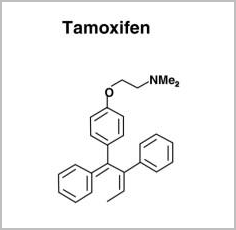Targets for estrogen action.
Question 9.0 (3/15/2011):
When members of a protein superfamily called nuclear receptors lose control of their normal signaling functions, the dysfunction contributes to the development of endocrine-related diseases including breast cancer, prostate cancer and ovarian cancer. One of the most widely used drugs for early-stage breast cancer therapeutics is Tamoxifen, which binds specifically to which nuclear receptor?
The answer was D: Estrogen receptor.
In women who have breast cancer, proliferation of breast cancer cells often is driven by estrogen, just as in the case of normal breast cells. Estrogens act on target tissues by binding to parts of cells called estrogen receptors. An estrogen receptor is a protein molecule found inside those cells that are targets for estrogen action. Estrogen receptors contain a specific site to which only estrogens (or closely related molecules) can bind.
In working on the development of antiestrogens, scientists have made a somewhat surprising discovery. Some drugs that block the action of estrogen in certain tissues actually can mimic the action of estrogen in other tissues.
Such selectivity is made possible by the fact that the estrogen receptors of different target tissues vary in chemical structure. These differences allow estrogen-like drugs to interact in different ways with the estrogen receptors of different tissues. Such drugs are called selective estrogen receptor modulors, or SERMs, because they selectively stimulate or inhibit the estrogen receptors of different target tissues. For example, a SERM might inhibit the estrogen receptor found in breast cells but activate the estrogen receptor present in uterine endometrial cells. A SERM of this type would inhibit cell proliferation in breast cells but stimulate the proliferation of uterine endometrial cells.
The first SERM to be investigated extensively for its anticancer properties is a drug called Tamoxifen. Tamoxifen blocks the action of estrogen in breast tissue by binding to the estrogen receptors of breast cells, thereby blocking the ability of estrogen to stimulate the proliferation of breast cells.
Question courtesy of Sichun Yang, assistant professor in the Center for Proteomics and Bioinformatics.
Week Nine Stats
How did you do? Stats: 111 people submitted answers for Question 9.0, 67 contestants selected the correct answer. Average time to correctly answer: 33.8 seconds. Fastest time? Two seconds! Week 9.0 leaders were sak107 with 120 points, smc39 with 119 points, pre with 116, lma17 with 113, blb74 with 108, atv9 and mcp65 with 106 a piece, jps8 with 105 points, and djj40 and lab139 with 104 each rounding out the top 10.
Take a shot at the next question, will be posted on Tuesday, April 26, 2011. See other past questions and answers.
